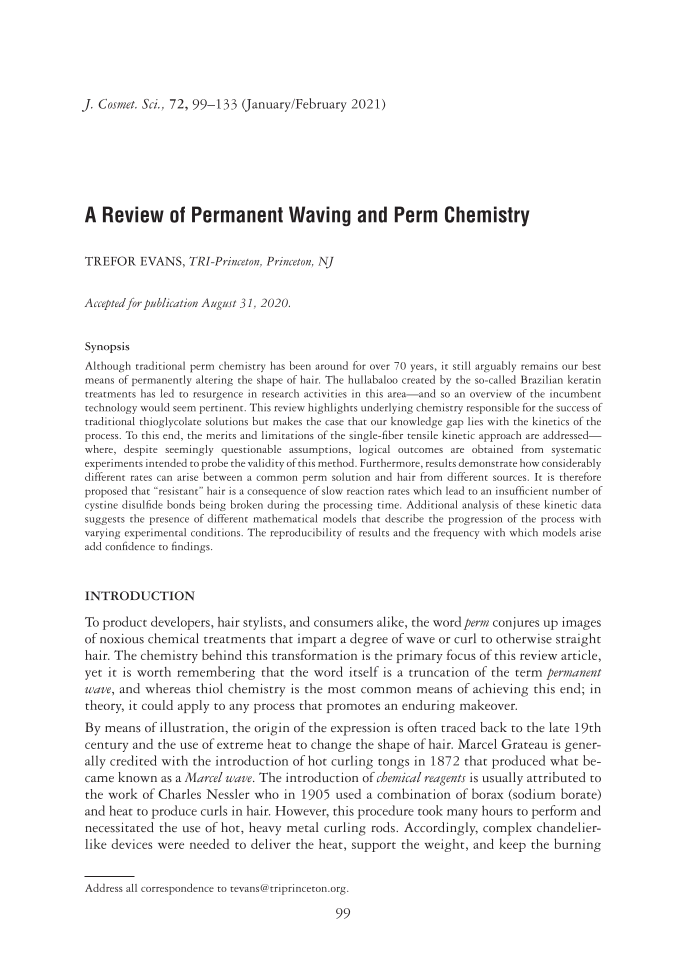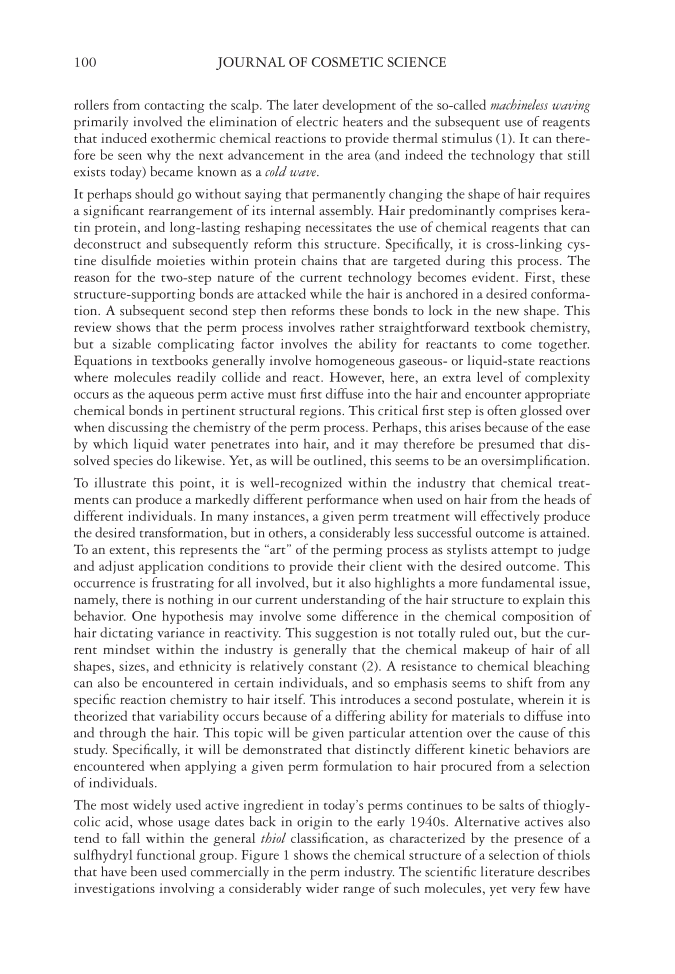J. Cosmet. Sci., 72, 99–133 (January/February 2021) 99 A Review of Permanent Waving and Perm Chemistry TREFOR EVANS , TRI-Princeton, Princeton, NJ Accepted for publication August 31, 2020 . Synopsis Although traditional perm chemistry has been around for over 70 years, it still arguably remains our best means of permanently altering the shape of hair. The hullabaloo created by the so-called Brazilian keratin treatments has led to resurgence in research activities in this area—and so an overview of the incumbent technology would seem pertinent. This review highlights underlying chemistry responsible for the success of traditional thioglycolate solutions but makes the case that our knowledge gap lies with the kinetics of the process. To this end, the merits and limitations of the single-fi ber tensile kinetic approach are addressed— where, despite seemingly questionable assumptions, logical outcomes are obtained from systematic experiments intended to probe the validity of this method. Furthermore, results demonstrate how considerably different rates can arise between a common perm solution and hair from different sources. It is therefore proposed that “resistant” hair is a consequence of slow reaction rates which lead to an insuffi cient number of cystine disulfi de bonds being broken during the processing time. Additional analysis of these kinetic data suggests the presence of different mathematical models that describe the progression of the process with varying experimental conditions. The reproducibility of results and the frequency with which models arise add confi dence to fi ndings. INTRODUCTION To product developers, hair stylists, and consumers alike, the word perm conjures up images of noxious chemical treatments that impart a degree of wave or curl to otherwise straight hair. The chemistry behind this transformation is the primary focus of this review article, yet it is worth remembering that the word itself is a truncation of the term permanent wave, and whereas thiol chemistry is the most common means of achieving this end in theory, it could apply to any process that promotes an enduring makeover. By means of illustration, the origin of the expression is often traced back to the late 19th century and the use of extreme heat to change the shape of hair. Marcel Grateau is gener- ally credited with the introduction of hot curling tongs in 1872 that produced what be- came known as a Marcel wave. The introduction of chemical reagents is usually attributed to the work of Charles Nessler who in 1905 used a combination of borax (sodium borate) and heat to produce curls in hair. However, this procedure took many hours to perform and necessitated the use of hot, heavy metal curling rods. Accordingly, complex chandelier- like devices were needed to deliver the heat, support the weight, and keep the burning Address all correspondence to tevans@triprinceton.org.
JOURNAL OF COSMETIC SCIENCE 100 rollers from contacting the scalp. The later development of the so-called machineless waving primarily involved the elimination of electric heaters and the subsequent use of reagents that induced exothermic chemical reactions to provide thermal stimulus (1). It can there- fore be seen why the next advancement in the area (and indeed the technology that still exists today) became known as a cold wave. It perhaps should go without saying that permanently changing the shape of hair requires a signifi cant rearrangement of its internal assembly. Hair predominantly comprises kera- tin protein, and long-lasting reshaping necessitates the use of chemical reagents that can deconstruct and subsequently reform this structure. Specifi cally, it is cross-linking cys- tine disulfi de moieties within protein chains that are targeted during this process. The reason for the two-step nature of the current technology becomes evident. First, these structure-supporting bonds are attacked while the hair is anchored in a desired conforma- tion. A subsequent second step then reforms these bonds to lock in the new shape. This review shows that the perm process involves rather straightforward textbook chemistry, but a sizable complicating factor involves the ability for reactants to come together. Equations in textbooks generally involve homogeneous gaseous- or liquid-state reactions where molecules readily collide and react. However, here, an extra level of complexity occurs as the aqueous perm active must fi rst diffuse into the hair and encounter appropriate chemical bonds in pertinent structural regions. This critical fi rst step is often glossed over when discussing the chemistry of the perm process. Perhaps, this arises because of the ease by which liquid water penetrates into hair, and it may therefore be presumed that dis- solved species do likewise. Yet, as will be outlined, this seems to be an oversimplifi cation. To illustrate this point, it is well-recognized within the industry that chemical treat- ments can produce a markedly different performance when used on hair from the heads of different individuals. In many instances, a given perm treatment will effectively produce the desired transformation, but in others, a considerably less successful outcome is attained. To an extent, this represents the “art” of the perming process as stylists attempt to judge and adjust application conditions to provide their client with the desired outcome. This occurrence is frustrating for all involved, but it also highlights a more fundamental issue, namely, there is nothing in our current understanding of the hair structure to explain this behavior. One hypothesis may involve some difference in the chemical composition of hair dictating variance in reactivity. This suggestion is not totally ruled out, but the cur- rent mindset within the industry is generally that the chemical makeup of hair of all shapes, sizes, and ethnicity is relatively constant (2). A resistance to chemical bleaching can also be encountered in certain individuals, and so emphasis seems to shift from any specifi c reaction chemistry to hair itself. This introduces a second postulate, wherein it is theorized that variability occurs because of a differing ability for materials to diffuse into and through the hair. This topic will be given particular attention over the cause of this study. Specifi cally, it will be demonstrated that distinctly different kinetic behaviors are encountered when applying a given perm formulation to hair procured from a selection of individuals. The most widely used active ingredient in today’s perms continues to be salts of thiogly- colic acid, whose usage dates back in origin to the early 1940s. Alternative actives also tend to fall within the general thiol classifi cation, as characterized by the presence of a sulfhydryl functional group. Figure 1 shows the chemical structure of a selection of thiols that have been used commercially in the perm industry. The scientifi c literature describes investigations involving a considerably wider range of such molecules, yet very few have
Purchased for the exclusive use of nofirst nolast (unknown) From: SCC Media Library & Resource Center (library.scconline.org)



















































































































































